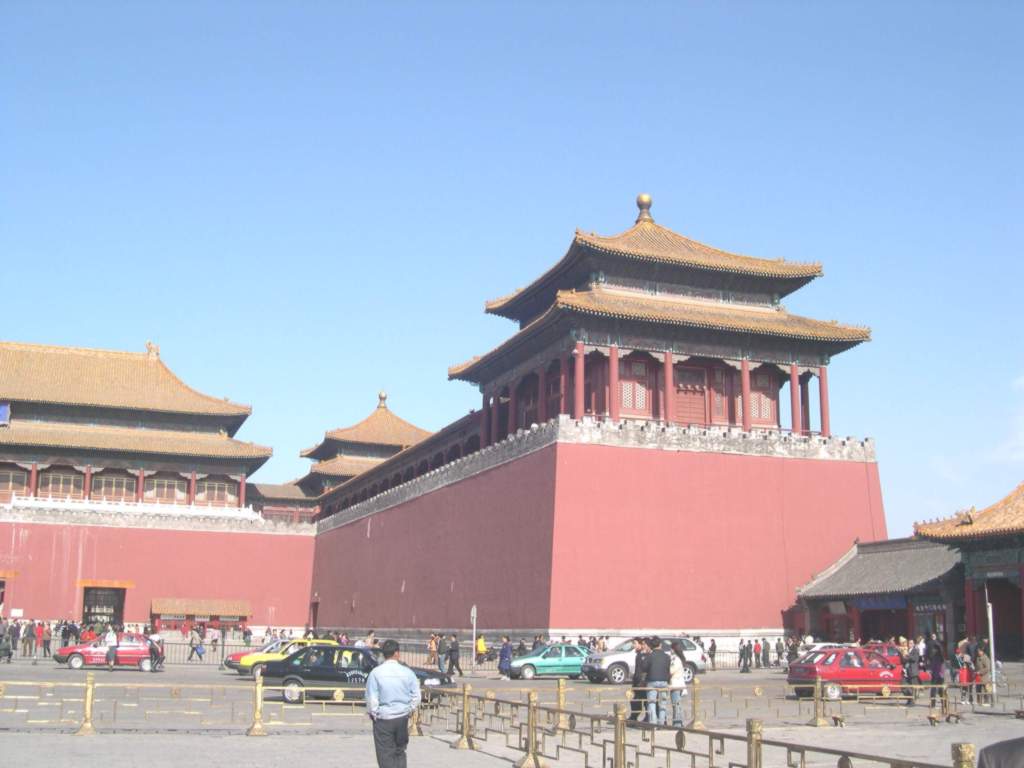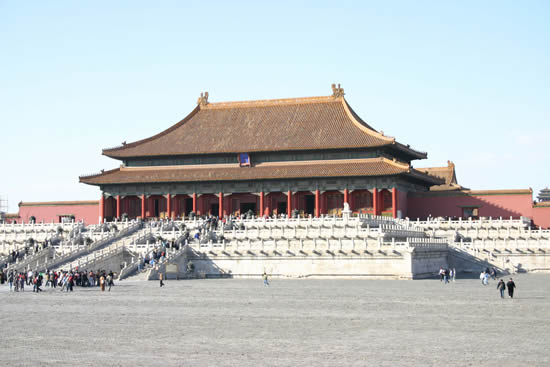Chinese Culture >> Forbidden City
Forbidden City
The Forbidden City or Forbidden Palace is located at the exact center of the ancient city of Beijing, was the imperial palace during the mid-Ming and the Qing Dynasties. Known now as the Palace Museum, its extensive grounds cover 720,000 square meters, 800 buildings and more than 8,000 rooms. The Forbidden City has the largest collection of preserved ancient wooden structures in the world, and was declared a World Heritage Site in 1987 as the "Imperial Palace of the Ming and Qing Dynasties". The Imperial Palace Grounds are located directly to the north of Tiananmen Square and are accessible from the square via Tiananmen Gate. It is surrounded by a large area called the Imperial City.
 Although no longer occupied by royalty, the Forbidden City remains a symbol of
Chinese sovereignty and the image of Tiananmen, the entrance to the Imperial
City, appears on the seal of the People's Republic of China. The Palace Museum
is now one of the most popular tourist attractions in the world. Recently, the
site has been under much renovation which has limited visitors to the main
courtyards and a few gardens.
Although no longer occupied by royalty, the Forbidden City remains a symbol of
Chinese sovereignty and the image of Tiananmen, the entrance to the Imperial
City, appears on the seal of the People's Republic of China. The Palace Museum
is now one of the most popular tourist attractions in the world. Recently, the
site has been under much renovation which has limited visitors to the main
courtyards and a few gardens.
The site where the Forbidden City stands today was part of the imperial city during the Yuan dynasty. When the Ming Dynasty succeeded it, the first Hongwu Emperor moved the capital to Nanjing and ordered that the Mongol palaces be razed in 1369. His son, Zhu Di, was created Prince of Yan with seat in Beijing. A princely palace was built on the site. In 1402, Zhu Li usurped the throne and became the Yongle Emperor. He moved the capital back to Beijing.
The construction of the Forbidden City started in 1406 and took 14 years and an estimated 200,000 men. The principal axis of the new palace sits to the east of the Yuan Dynasty palace, a design intended to place the Yuan palace in the western or "kill" position in feng shui. Soil excavated during construction of the moat was piled up to the north of the palace to create an artificial hill, the Jingshan hill
From its 1420 completion to 1644, when a peasant revolt led by Li Zicheng invaded it, the Forbidden City served as the seat of the Ming Dynasty. The following Qing Dynasty also occupied the Forbidden City. In 1860, during the Second Anglo-Chinese Opium War, British forces managed to penetrate to the heart of the Forbidden City and occupied it until the end of the war, being the only foreign power to do so.
After being the home of 24 emperors—fourteen of the Ming Dynasty and ten of the Qing Dynasty—the Forbidden City ceased being the political center of China in 1912 with the abdication of Puyi, the last Emperor of China. He was, however, allowed and, in fact, required to live within the walls of the Forbidden City, until a coup launched by a local general in 1924. Puyi was forced out, and the Palace Museum was established in the Forbidden City. Having been the imperial palace for some five centuries, the Forbidden City houses numerous rare treasures and curiosities. These were gradually catalogued and put on public display. However, with the Japanese invasion of China, the safety of these national treasures were cast in doubt, and they were moved out of the Forbidden City. In 1947, after they had been moved from one location to another inside mainland China for many years, Chiang Kai-shek ordered many of the artifacts from the Forbidden City and the National Museum in Nanjing to be moved to Taiwan, where they formed the core of the National Palace Museum in Taipei. This action has been extremely controversial, with some regarding it as looting while others regarding it as safekeeping, especially after the events of the Cultural Revolution on the mainland.
Rectangular in shape, the Forbidden City is the world's largest palace complex and covers 720,000 square meters (178 acres, or 0.28 square miles). Surrounded by a six meter deep moat and a ten meter high wall are five halls, seventeen palaces, and numerous other buildings. The Forbidden Palace is reputed to have a total of 9,999.5 rooms. However, according to surveying by the Palace Museum, there are about 8,600 existing rooms. (The majority of buildings in the Forbidden City have an odd number of rooms, distributed symmetrically about an axis. However, the Imperial Library had six rooms as a charm against fire, because the number six is associated with water in astrology. So that the building does not look out of place, the sixth room was built very small, hence the half-room.)
The wall has a gate on each side. At the southern end is the Meridian Gate (technically, Tiananmen Gate is not part of the Forbidden City); to the north is the Gate of Divine Might, which faces Jingshan Park. The distance between these two gates is 960 meters, while the distance between the gates in the east and west walls is 750 meters. The walls are thick and squat and were specifically designed to withstand attacks by cannons.
There are unique and delicately structured towers on each of the four corners of
the curtain wall. These afford views over both the palace and the city outside.
The Forbidden City is divided into two parts. The Outer Court, which includes
the southern and central sections, centers on three halls used for ceremonial
purposes, such as coronations, investitures, and imperial weddings. The three
halls include the magnificent Hall of Supreme Harmony, itself fronted by the
Gate of Supreme Harmony.. Apart from ceremony, the Outer Court also houses the
imperial library, archives, and lantern storage. The Inner Court includes the
northern, eastern, and western parts of the Forbidden City, and centers on
another three halls used for day-to-day affairs of state. The most important
among these is the Palace of Heavenly Purity. The Inner Court is where the
Emperor worked and lived with his family, eunuchs and maid-servants.
At the northern end of the Forbidden City is the imperial garden. It is home to some relatively old trees, most between 100 and 300 years of age.
The Forbidden City is surrounded by royal gardens. To the west lies Zhongnanhai, the complex of buildings centered on two lakes which serves as the central headquarters for the Communist Party of China. To the north-west lies Beihai Park, which also centers on a lake and is a popular park. To the north lies Jingshan Park, also known as Jing Shan or Coal Hill, where the last Ming emperor hanged himself as the rebel army overran his palace.
The individual buildings within the Forbidden City housed many important members of the Chinese aristocracy. The famous national civil service exams were given inside one of these buildings. The royal color was yellow, and that color dominates the rooftops. On each corner of the roofs, there are small statuettes, the number of which designated the power of the person living within the building. The number 9 was reserved for the emperor. Only one building has 10 statuettes at each corner.
Forbidden City Replica in the United States
Forbidden Gardens in Katy, Texas, is a fascinating outdoor museum replicating some of China's major historic scenes. Guided tours take you back to the third century BC to view the first Emperor's amazing 6,000 piece terra-cotta army replicated in 1/3 scale. The tour continues to the intricately detailed miniatures of the famous Forbidden City in Beijing which served as palaces for nearly 500 years of Imperial rule. Come and experience the mystery and magic of Imperial China. Forbidden Gardens is a must-see for everyone who wants to embark on an unforgettable journey to a faraway land without stepping outside of Texas..
